2021 Harley-Davidson Pan America 1250 Special Review - First Ride

This one's going to upset the haters
Well folks, the latest Harley machine to grace the motorcycle market jumps, slides, and rips with the best of them – “them” of course, being the heavyweight adventure motorcycle class. The entire world had its reservations, some optimistic, and plenty pessimistic. But after cruising for two days on the 2021 Harley-Davidson Pan America 1250 Special, it’s clear that it’s adept at much more than just that.
2021 Harley-Davidson Pan America 1250 Special
| Engine | 18.0/20 |
| Suspension/Handling | 13.75/15 |
| Transmission/Clutch | 9.0/10 |
| Brakes | 7.5/10 |
| Instruments/Controls | 4.5/5 |
| Ergonomics/Comfort | 8.0/10 |
| Appearance/Quality | 8.0/10 |
| Desirability | 9.0/10 |
| Value | 9.0/10 |
| Overall Score | 86.75/100 |
Our test spanned nearly 350 miles over two days covering a variety of terrain from serpentine tarmac to loose, sandy soil. Whether the Pan Am was on two wheels or none, it handled everything we put it through with, you guessed it, aplomb. The H-D Pan America is undeniably a well-thought out adventure machine with more than a handful of unique features that set it apart from its rivals in a heavily competitive segment. Some of those features may be the kind to tip the scales for the ADV-curious. While there’s always room for improvement, Harley-Davidson’s latest machine is ready to take the Motor Co. into uncharted territory.
Bolts, nuts, and c-clips
Those are a few of the only parts Harley-Davidson was able to carry over to use on its new adventure bike. It should come as no surprise that the Pan America 1250 is an entirely new machine. From the chassis, to its Revolution Max 1250cc V-Twin, the Pan America is unlike anything the Motor Co has previously developed.
The all-new powerplant’s spec sheet looks more akin to the European ADV V-Twins than to its predecessors, with a 13:1 compression ratio inside its single-piece aluminum cylinders. Knock sensors are used to retard timing in the instance that 91 octane fuel is hard to come by. Making up its 1250cc is a 104.9mm bore and 72.1mm stroke. Dual spark plugs are used for combustion, and oil jets positioned below the piston aid in cooling. Dual OverHead Camshaft (DOHC) design and Variable Valve Timing (VVT) also showcase the modernity in the MoCo’s latest mill.
The two crankshaft journals are offset by 30 degrees in the 60-degree V-twin, resulting in a 90-degree firing order. We’re told the engine was meticulously scrutinized to provide durability while also being as light as possible. The rocker covers, camshaft covers, and stator cover are all made from magnesium.
One major feature that isn’t new to H-D, but is new to ADV, is the inclusion of hydraulic lash adjusters in the valve train which, in theory, mean the customer will no longer need to worry about valve adjustments in their service schedule. The design ensures the valve actuators are in constant contact with the valves which Harley tells us also allowed them to use more aggressive cam lobe profiles.
Inside the unified cases are three oil scavenging pumps, two counterbalancers, and a slip and assist cable actuated clutch for smooth shifts back and forth between its six gears. The ol’ “We don’t speak to future products” was given when asked about the possibility of a quickshifter in the future. The airbox is located beneath the fuel tank, which will need to be removed for servicing the air filter. We’re told the quick disconnect fuel line and three bolts it takes to pull the tank make this service easy. Not as easy, of course, as on other adventure bikes that give access under the seat. In a further, but necessary departure from H-D’s norm, a chain final drive is used.
The stainless steel exhaust situates the catalytic converter under the rider’s right foot which, as one might assume, puts off a substantial amount of heat, but more on that later. What’s a Harley without Screamin Eagle accessories?! Half of our test units were equipped with the 6.5-pound lighter (42% lighter than stock), but auditorily similar, Screamin Eagle Street Cannon exhaust with a Ti muffler and carbon tip.
What makes you so Special?
All of the Pan Americas we had the chance to ride were the Pan America 1250 Specials equipped with a few choice bits and bobs from the P&A catalog. Special motorcycles get:
- Semi-active front and rear suspension with Vehicle Load Control
- Tire pressure monitoring system
- Center stand
- Multi-position rear brake pedal
- Side brush guards
- Aluminum skidplate
- Daymaker Signature adaptive headlight (IMU controlled for illuminating corners)
- Hand guards
- Heated grips
- Öhlins steering damper
- Factory installed options include Adaptive ride height and Tubeless spoked wheels
My ride was outfitted with both the adaptive ride height ($1000) and tubeless spoked wheels ($1650 from the parts catalog or $500 when added at time of purchase) as well as the beefier skid plate ($350), radiator shield ($150), and Muffler guard ($160) for our day in the dirt. Everyone in attendance also had the option of swapping to a taller (one inch) or lower seat (one inch in the other direction) as well as swapping in 2-inch higher risers for the handlebars. The stock setup was adequate for me, and between the two-way adjustable seat position, the lower position’s 31.1 inch seat height felt a-okay. Although for touring, I would probably position the seat in its taller position for less bend at the knee.
Of course the Adjustable Ride Height (ARH) makes the biggest difference in keeping riders confident and firmly footed on the ground. The semi-active Showa suspension components, when fitted with ARH, lower the motorcycle as it comes to a stop by one to two inches. In the Auto setting, the adjustment goes unnoticed and speeds up or slows down its descent based on a number of factors such as speed, deceleration rate, and lever state. The system won’t start lowering until speed is reduced to approximately 15.5 mph. There are also Short Delay and Long Delay modes which lower the motorcycle 0.5 seconds and 2 seconds after the machine is stopped. When asked if this feature could cause the motorcycle’s 8.3 inches of ground clearance to dwindle at an inopportune time off-road, the suggestion was to Lock the ARH, essentially disabling, if this was of concern.
The Adaptive Ride Height feature is another of those standouts like the hydraulic lash adjusters. One of the biggest barriers to entry to those looking at adventure bikes is seat height. It can be daunting to have to tiptoe on a tall 550-pound motorcycle. Even for those of us who manage to feel comfortable on these machines, Harley’s ARH was a welcome feature and possibly a game changer for interested parties.
The suspension components themselves are made by Showa with its 47 mm Balance Free Fork (BFF) and Balance Free Rear Cushion-lite rear shock. You get 7.48 inches of travel out of both ends and preload is constantly monitored to remain even keel at 30% sag. Damping characteristics are tied to ride modes, but can be adjusted by preference in the custom ride modes further to Sport, Balanced, Comfort, Off-Road Soft, or Off-Road Firm. The shock is connected to the swingarm via a linkage.
The Pan America’s frame is a three parter with a front, mid-, and tail (subframe) section all using the engine as a central stressed member. Passenger footpegs bolt to the subframe which would suggest they can be removed, but the right footpeg bracket is also used as a hanger for the exhaust and a mounting point for luggage. Currently, we’re told H-D doesn’t have an accessory option for a passenger footpeg “delete”. The swingarm is cast aluminum for weight savings.
The aluminum fuel tank holds 5.6 gallons. Considering the claim of 46 mpg, that should yield somewhere north of 250 miles. During our ride, one unfortunate soul ran out of fuel with 181 miles on the trip meter while my bike was somewhere around 195 with its fuel light on. As always, your mileage may vary.
Brembo supplies the braking components, with dual 320mm discs up front clenched by radially mounted four-piston monoblock calipers. Out back is a single-piston caliper and a 280 mm disc. Both levers are adjustable and the Special gets a swiveling brake pedal to adjust height. The higher position of the pedal was fine for street riding, but for our off-road day, I had the pedal adjusted so it was in line with the footpeg. I was told this was the highest it could be adjusted, which worked great for our day on the trails. Feel was smooth and progressive at both ends. The front and rear brakes are linked but have varying levels of ABS intervention depending on the mode selected. In Off-Road/Plus or Custom Off-Road/Plus, ABS and the linked function can be disabled to the rear wheel with a long press of the “mode” button on the right switchgear. Front-wheel ABS remains on at a lower intervention rate.
Our tubeless spoked wheels fit 120/70R19 and 170/60R17-inch tires and weigh 14 lbs more than the stock cast aluminum units. For our street ride, our bikes were shod with Michelin Scorcher Adventure tires specifically developed between Harley-Davidson and Michelin for the Pan America. For the day spent mostly off-road, H-D spooned on chunkier meats; the Michelin Anakee Wild. We were informed that this is a factory accessory option, and when installed, the motorcycle needs to be “reflashed” in a way to recalibrate to the new rubber. This includes limiting the top speed to 110 mph because the Wilds are only rated to 110 mph. Doesn’t sound very wild to me…
The Motor Co. claims 534 pounds wet for the base Pan America and 559 pounds wet for the Special model. We were told that our bikes as tested, during our off-road ride, were somewhere north of 574 with the spoked wheels and extra protection. Pricing starts at $17,319 for the base model and $19,999 for the Special, but if you want anything other than black it’ll cost ya an extra $250 to $350.
In terms of technology, the Harley-Davidson Pan America punches with its class. We have three dedicated ride modes for the street with Rain, Road, and Sport and two off-road modes: Off-Road/Plus and Custom Off-Road/Plus as well as two fully customizable modes. Custom Off-Road/Plus and a second Custom B mode are only available on Special models. IMU-based traction control and ABS keep the bike in line despite one’s poor choices and are joined by front and rear wheel lift mitigation. Parameters able to be customized include: Engine map (four options), Engine braking (five levels), Throttle response (five levels), Traction control (five levels including off, which has to be done with a long press of the button on the right switchgear), ABS (five levels including off, which puts the Plus in Off-Road Plus, also actuated with a long press of the mode button while in Off-Road mode), Suspension Damping (five levels), Adaptive Ride Height (four levels including locked). I’ll save you the confusing list of acronyms Harley uses to describe most of these features.
The Pan America has all of the IMU-based features above and also Hill Hold, Cornering Enhanced Drag-Torque Slip control (C-DSCS), which aids the slip and assist clutch function while cornering to prevent rear wheel hop. Tire pressure monitoring is also included. All of this techno wizardry can be dealt with on the 6.8-inch TFT touchscreen or with one or more of the 25 buttons between the two switchgear modules. The TFT display also offers Bluetooth connectivity (calls, texts, navigation with the HD app, music) and customization of which info the rider prefers to see.
LED lighting is used throughout, and the Special is equipped (an accessory option for base models) with the Daymaker Adaptive cornering headlight that illuminates corners based on lean angle. The Front signals are also nicely tucked behind the brush guard to prevent them from being the first thing to get broken off in the event of a tip over.
Any parts and accessories available? Ha, you can bet your sweet Screamin’ Eagle there is! Seriously though, the protection, luggage, and ergonomic adjustment Harley has offered for the Pan America appear to be robust, well-made, and well-thought out. For gear, the MoCo has partnered with REV’IT! to bring quality licensed options for those looking for them, and the hard luggage has been developed in coordination SW Motech, another well-known brand in the ADV community.
I know what you’re thinking: It sounds kind of awesome according to the information dump above, but how does it function? Is she a ripper? Can it handle more than the odd fire road that a confident rider could also ride his or her Street Glide down?! Sit back and settle in, all is about to be answered.
Panning America
Just like with a new dance partner, it takes time to develop into a smooth rhythmic fluidity of motion, but I knew from the moment I twisted my right wrist on the frontage road just outside the Rawhyde Zakar complex that I was in for a good time. “Damn,” I thought to myself as a big ol’ smile stretched across my face, “this is going to be fun.”
As with most motorcycles the engine is the star of the show, and while the Pan America’s appeal is definitely the sum of its parts, the motor is crucial to the machine’s success or failure. The MoCo is claiming 150 horsepower at 9,000 rpm and 94 lb-ft of torque at 6,750 rpm. The meat of that torque in Sport mode comes on fast and relentlessly after 3,000 and continues on to its 9,500 rpm redline. Clutch modulation is smooth and effortless while the slip and assist clutch coupled with the C-DSCS is one of the smoothest we’ve used.
Ergonomically, for me at 5-foot 8-inches, the standard seat and risers worked perfectly. The handlebar bend isn’t my favorite as the bars are swept far back from the risers, but it was mostly the width and distance from the seat that reminded me of a cruiser with my hands wide apart and elbows nearly locked. It didn’t provide much fatigue over our day’s ride, but if I were just pounding out the miles and a long tour on the freeway, I might want to be able to stretch here and there. Cruise control comes standard which makes dealing with a stiff shoulder a might easier rather than having to stop to stretch. The footpegs and bars delivered no annoying vibes at cruising speed.
As we set out onto the freeway destined for twisty backroads, I easily propped up the four-position adjustable windscreen with one hand. The mechanism feels a bit flimsy, and later would become much more difficult to use after being coated in dust. Still, it worked fine at the beginning of the day. There are also high and low versions available. Cruise control – standard on both models – is easily set and adjusted on the left switchgear and with ride mode in Sport, the suspension is set firm and ready.
Once we made it to the fun part of our street ride, it was time for photos, which I was okay with because the ride had been, how shall I say, a bit sedate pace-wise. It was nice to get to use full throttle and to test the brakes during the photo passes, even if it was just for a few corners at a time. Though the bike isn’t the quickest steering through a set of switchbacks, the wide handlebar lets you command the machine effectively.
The standard cornering enhanced linked braking does a fantastic job of getting the Pan America slowed. On more than one occasion I felt the rear ABS kicking in while I was braking hard with the front lever and just a scosche of pressure on the rear. I was impressed with the braking components and the linked brake’s ability to keep the bike very firmly planted under hard braking conditions.
Some complained that Sport mode’s throttle was too touchy for general riding, preferring Road mode’s smoothness over Sport’s sharp throttle response. I couldn’t get enough in Sport mode, holding the throttle to the stop any time that I could just to feel the rush of power that the Revolution Max motor would deliver. Once we got back onto the freeway though, I did prefer Road mode’s “balanced” suspension damping which offered a smoother ride for highway cruising.
Initially, I couldn’t feel the automatic Ride Height Adjustment doing its thing at all, I was just welcomed with the pavement closer to my soles than ever before on an ADV machine. It works quite well and was helpful in a myriad of ways only shorter riders can understand. It was odd however, that when you’re off of the bike and the cycle is jostled around that the shock begins to pump itself back up. Meaning that in theory, if you move the bike around alot while it’s off, the seat height will creep back up. Of course, as soon as you start the machine with weight on it, it sinks back down.
At our first photo pass I saw our dearly departed (from MO) EiC Kevin Duke struggling with the kickstand on soft ground. “It wouldn’t be a Harley without a nerve-wracking kickstand, would it?”, I yelled. The kickstand bares some semblance of its cruiser brethren with a bit of movement locking it in once leaned over.
Navigating the array of technology and adjustability took some time. While I didn’t find it as intuitive as other interfaces I’ve used, I was comfortable with it by the end of day two, so naturally any owner living with the machine will get used to its intricacies.
Our street ride ended with more than a few miles of wide sandy freshly graded road. Off-Road Plus was used, and I left traction control at its stock setting. This kept the motorcycle reined in nicely but didn’t deliver quite the hit of power I like to use to spin up the rear tire for turning. But, since we had the Michelin Scorcher tires on the bikes for this day, it did a decent job of keeping things uneventful. Eventually though, the immature tire abuser in me pushed and held the TC button to disable the feature entirely allowing for lots of wheel spin courtesy of the 1250’s 94 lb-ft of torque.
After a day of sampling what the Pan Am had to offer on-road, I couldn’t wait to have more knobby tires equipped and a full day in the dirt.
The next day we set out down the highway in search of Burro Schmidt’s life’s work. By the time we reached the gravelly dirt road, our tire pressure was reading 41 F / 47 R on the too small text on the left side of the screen (and if I’m saying the text is too small, imagine what the old guys are going to say, ha!). When asked if we would be dropping pressures, we were met with a discussion between H-D staff and ride leaders that ended with, “No”. Well, we certainly wouldn’t be getting any pinch flats, but things are going to be a bit harsh and slick. With that decision made, we set off down the trail.
Today, I started off in Off-Road Plus, disabling the cornering traction control, linked braking, cornering ABS, front and rear wheel lift mitigation, and adjusting the damping to Off-Road Soft while keeping a low intervention of ABS on the front wheel (which cannot be disbaled). It wasn’t long before I set some preferences up in the Custom Off-Road/Plus setting which included dialing in sharper throttle response, less engine braking, Off-Road TC and ABS (because I would be turning TC off entirely with the switchgear), and Off-Road Firm for the suspension while leaving the Off-Road engine map as is. I also left the Ride Height Adjustment in auto.
This proved to be a better test of just how well the bike performed without being reined in with all of its electronic aids. In terms of size, the Harley-Davidson Pan America feels quite small. The low seat and ARH definitely play a part, but the V-Twin layout and overall lowness of the machine make it feel pretty compact when compared to most heavyweight adventure bikes. This feeling translates into its handling on the trail as well.
We began picking up the pace as we meandered through rocky Jeep roads around the El Paso mountains. Rocks gave way to patches of sand here and there with a few climbs and descents sprinkled in. Nothing we traversed was overly taxing, but the pace we were keeping, which ranged between 35-55 mph (I was told by Revzilla’s Spurg), felt entirely comfortable. Sure, we could push to go faster, but attempting to stay out of the dust as well as the occasional bottoming of the skid plate suggested this was a comfortable pace. I was having a blast and felt totally confident with the Pan America off-road.
Unfortunately, as you do, we had two decent crashes at speed during the day. One was our ride leader, the other, a journalist in group two. In both circumstances, the riders were okay. Both get offs saw the front end of the bike suffering pretty significant damage. I can only speak to the bike that I saw, but our lead rider’s machine had augured in nose first off the side of the trail. Everything above the headlight cowl was ripped from the bike including its TFT display. When later asked if the machine would start and run without the display attached, we were told yes, but H-D employees opted to load it into the four-wheel drive truck giving chase. I didn’t see this, so I can only take their word. This got me thinking about some of the components that don’t feel quite as robust as they might need to be on the PA. The windscreen was one of those components, as were the snap-in handguards, which had continuously vibrated themselves off of the bar ends during bumpy high speed runs. Here and there, fit and finish isn’t quite on par with many of the European or Japanese machines that come to mind.
Later in the day, we got to have a bit of “free time” at the Trona Pinnacles. This allowed for some additional testing in deep sand, some small jumps, and rocky loose surfaces and sidehills. All of this helped to illustrate what I had already come to feel on the trails earlier in the day: the Pan America is a really well balanced bike. It doesn’t feel top heavy at all until you’re picking it up off the ground, and with good tires like the Anakee Wilds, the bike can handle just about anything you want to throw at it, assuming you’re also game.
Small jumps were effortless and landings were smooth and controlled. Again, Off-Road Firm would be the suggested setting for anyone experienced and looking to push the machine’s limits. After adjusting the rear brake pedal higher, and with the bars rolled forward – which made for an awkward position while seated – the Pan Am was very comfortable to ride while standing, which we were for most of the second day.
Former EiC Duke posed a question that made me start considering the competition: What’s a better dirt bike between this and its competitors? Some quickly lauded the Pan Am with their praises. For me, I had to think about it, but it’s been a while since I’ve been so immediately comfortable riding a big adventure bike to the levels that we had the PA. Sure, it could use some more ground clearance, if I want to pick nits, the suspension could offer more adjustability, but the bike had not only dealt with what we had thrown at it, but was a lot of fun while doing so.
Looking at other bikes in this segment of the ADV category, the Pan America 1250 Special slots in right alongside them in price, technology, and performance while also delivering innovative solutions to problems that haven’t really been addressed before. I suppose that’s the nice thing about having a clean slate.
Time will tell
Only time will tell how the Harley-Davidson Pan America will hold up under abuse. Our two days with the machine isn’t enough to know how it will fare in the long haul. But it was absolutely clear that Harley has built a proper adventure bike that should appeal to a large swatch of riders, whether it be those new to adventure touring, new to Harley-Davidson, or veterans looking for something new and with some compelling offerings to boot.
There’s not much to fault the Pan Am for. H-D has built an exciting motor in its Pilgrim Road facility and transplanted it into an exciting motorcycle in York, PA. I see a lot of people making comments about the machine online who haven’t a clue what it’s like to ride the thing. I guess they always say if you have haters, you’re doing something right, and Harley-Davidson has done more than a few things right with the Pan America.
Join other fans of the Harley-Davidson Pan America at PanAmericaForums.com
2021 Harley-Davidson Pan America 1250 Special
+ Highs
- New motor is plenty torquey
- Not as top heavy as other ADV machines
- Hydraulic valve lash adjusters and ARH are standout features in its class
– Sighs
- Some components don’t seem ready for what ADV may entail (crashing)
- Understanding all of the electronics and how to use them
- Ride Height Adjustment pumping back up when the bike is off
In Gear
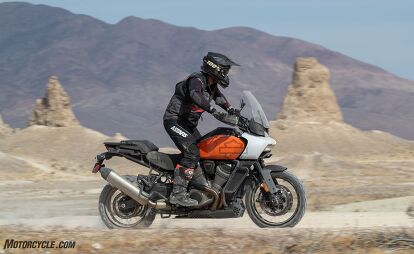
- Helmet: Shoei Hornet X2 $600
- Helmet #2: Alpinestars Supertech M8 $580
- Jacket: Alpinestars Venture $250
- Pants: Alpinestars Raider V2 $270
- Pants #2: Alpinestars Venture R $150
- Shoes: Alpinestars CR-X $200
- Boots: Alpinestars Tech 7 Enduro $390
Gloves: Alpinestars Highland $100
2021 Harley-Davidson Pan America 1250 Specifications | ||
|---|---|---|
Pan America 1250 | Pan America 1250 Special | |
| Engine | Revolution Max 1250 | |
| Valves | Chain-driven, DOHC, hydraulic self-adjusting lifters, intake & exhaust VVT; four valves per cylinder | |
| Bore x Stroke | 105 mm x 72 mm | |
| Displacement | 76.3 cu in (1,252 cc) | |
| Compression Ratio | 13.0:1 | |
| Fuel System | Electronic Sequential Port Fuel Injection (ESPFI) | |
| Air Cleaner | Downdraft intake, tuned velocity stacks, washable filter media | |
| Exhaust | 2-into-1-into-1; catalyst in header | |
| Lubrication System | Pressurized Wet Sump | |
| Horsepower | 150 hp at 9000 rpm | |
| Torque | 94 lb-ft. at 6750 rpm (claimed) | |
| Final Drive | Chain, 19/48 ratio | |
| Clutch | Mechanical, 8 plate wet, assist & slip, 1090N | |
| Transmission | 6-Speed | |
| Frame | Stressed-member, high strength low alloy steel trellis frame; stamped, cast, and forged junctions; MIG welded; aluminum forged mid-structure | |
| Swingarm | One-piece cast aluminum | |
| Front Fork | 47mm inverted fork with compression, rebound and spring preload adjustability. Aluminum fork triple clamps. 7.5 inches of travel. | 47mm inverted fork with electronically adjustable semi-active damping control. Aluminum fork triple clamps. 7.5 inches of travel. |
| Front Fork Option | N/A | 47mm inverted fork with electronically adjustable semi-active damping control and Adjustable Right Height (ARH). Aluminum fork triple clamps. |
| Rear Shocks | Linkage-mounted, piggyback monoshock with compression, rebound and hydraulic spring preload adjustability. 7.5 inches of travel. | Linkage-mounted monoshock with automatic electronic preload control and semi-active compression & rebound damping 7.5 inches of travel. |
| Rear Shock Option | N/A | Linkage-mounted monoshock with automatic electronic preload control and semi-active compression & rebound damping and Adjustable Ride Height (ARH) |
| Front Brake | Radially mounted, monoblock, 4-piston caliper, 320mm rotor | |
| Rear Brake | Floating, single piston caliper, 280mm rotor | |
| Front Wheel | 19-inch aluminum cast, satin black | |
| Rear Wheel | 17-inch aluminum cast, satin black | |
| ABS | Standard | |
| Tires | Michelin Scorcher Adventure, Radial | |
| Front Tire Size | 120/70R19 60V | |
| Rear Tire Size | 170/60R17 72V | |
| Rake / Trail | 25° / 4.3 inches | |
| Wheelbase | 62.2 in. (1,580 mm) | |
| Maximum Lean Angle | 42° left, 42° right | |
| Lights | Daymaker Signature LED headlamp, low and high beam with signature position lighting. LED tail lamp, LED bullet turn signals | Daymaker Adaptive LED Headlamp with 6-segment LED banking lamp, LED tail lamp, LED bullet turn signals |
| Fuel Capacity | 5.6 gal. (1 gal. reserve) | |
| Fuel Economy | 46 mpg (5.1 l/100 km) | |
| Warranty | 24 months (unlimited mileage) | |
| Instrumentation | 6.8 inch viewable area TFT display with speedometer, gear, odometer, fuel level, clock, trip, low temp alert, side stand down alert, TIP over alert, cruise, range and tachometer indication BT capable – phone pairing to access phone calls, music, navigation (H-D App ONLY) | 6.8 inch viewable area TFT display with speedometer, gear, odometer, fuel level, clock, trip, ambient temp, low temp alert, side stand down alert, TIP over alert, cruise, range and tachometer indication BT capable – phone pairing to access phone calls, music, navigation (H-D App ONLY) |
| Length | 89.2 in. (2,265 mm) | 89.2 in. (2,265 mm) |
| Overall Width | 38 in. (965 mm) | 38 in. (965 mm) |
| Overall Height | 59.4 in. (1,510 mm) | 59.4 in. (1,510 mm) |
| Seat Height, Laden | 31.8 in. (807 mm) | 31.1 in. (789 mm), 30.4 in. (772 mm) with optional suspension |
| Seat Height, Unladen | 34.2 in. (869 mm) | 33.4 in. (850 mm), 32.7 in. (830 mm) with optional suspension |
| Ground Clearance | 8.3 in. (210 mm) | |
| Weight, As Shipped | 503 lb. (228 kg), claimed | 527 lb. (239 kg), claimed |
| Curb Weight | 534 lb. (242 kg), claimed | 559 lb. (254 kg), claimed |
We are committed to finding, researching, and recommending the best products. We earn commissions from purchases you make using the retail links in our product reviews. Learn more about how this works.
Become a Motorcycle.com insider. Get the latest motorcycle news first by subscribing to our newsletter here.

Ryan’s time in the motorcycle industry has revolved around sales and marketing prior to landing a gig at Motorcycle.com. An avid motorcyclist, interested in all shapes, sizes, and colors of motorized two-wheeled vehicles, Ryan brings a young, passionate enthusiasm to the digital pages of MO.
More by Ryan Adams



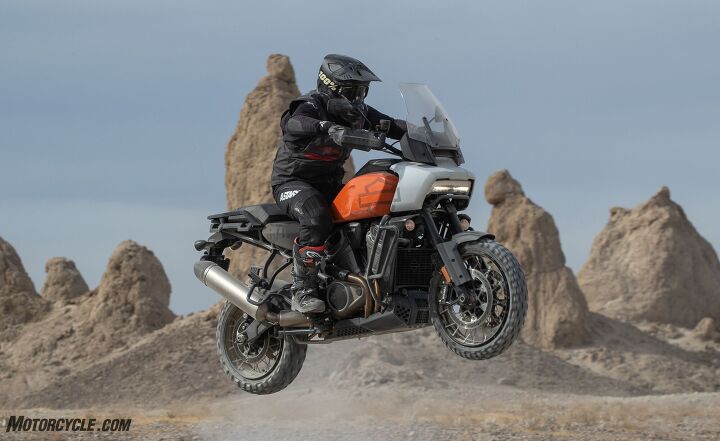


































































































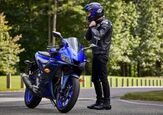
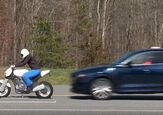
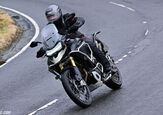
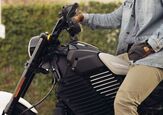
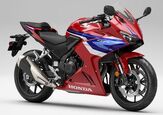
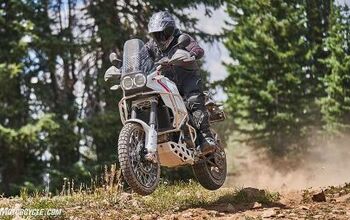
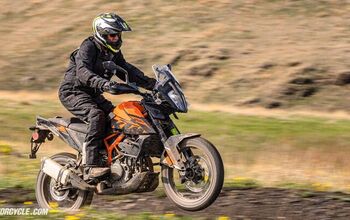
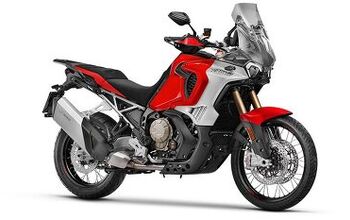



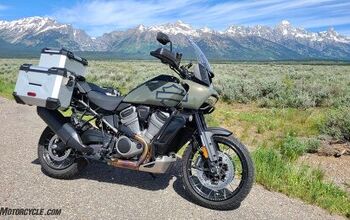

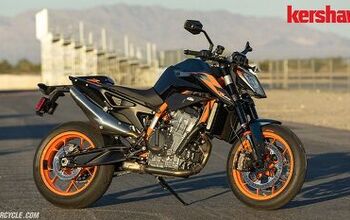
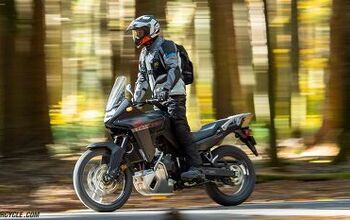
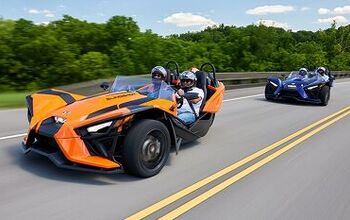
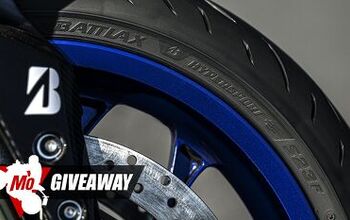
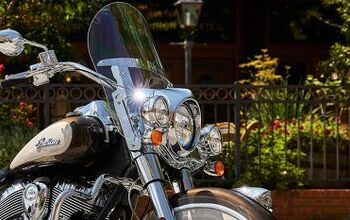
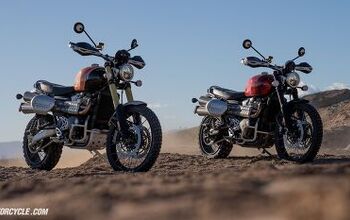
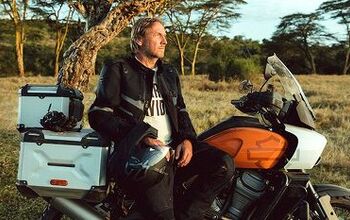
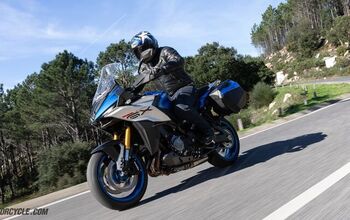

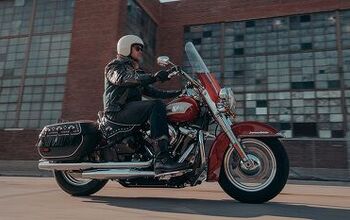
Comments
Join the conversation
Before you hate on the PA wait ‘till you’ve ridden it. It’s mighty impressive. Feels like the L-Twin MultiStrada engine sound and power-wise (at least to me). Steering is gloriously smooth thanks to the damper. Brakes and clutch are shockingly good for a Harley and just flat out excellent. I haven’t ridden the new V4 Multi or the new KTM SA, but honestly, I’d take the PA over all the other competitors (yes, even the mighty GS) It’s a hoot to ride.
A lot of those problems with the Special literally come off if you just get the base Pan-Am. As does a lot of the price.